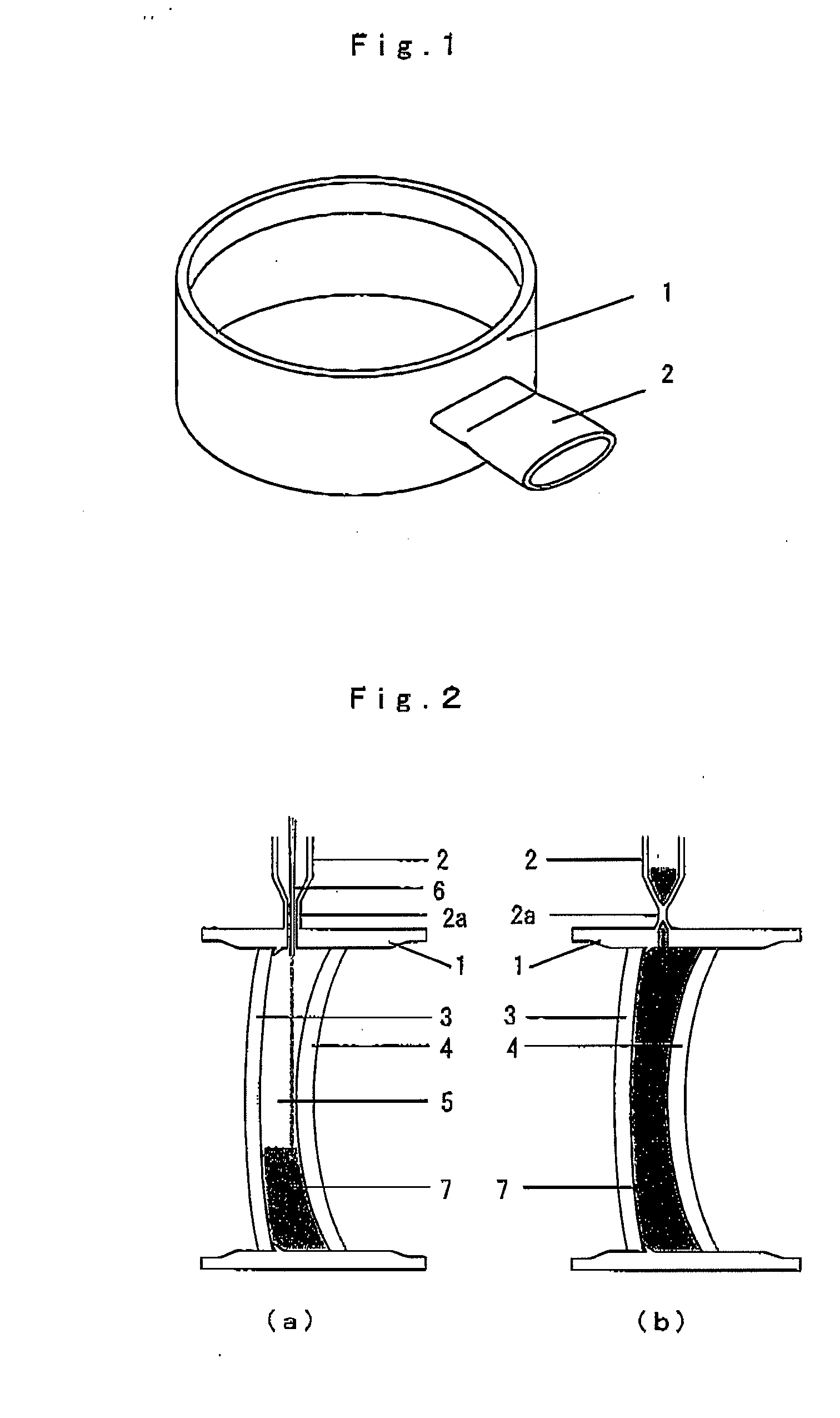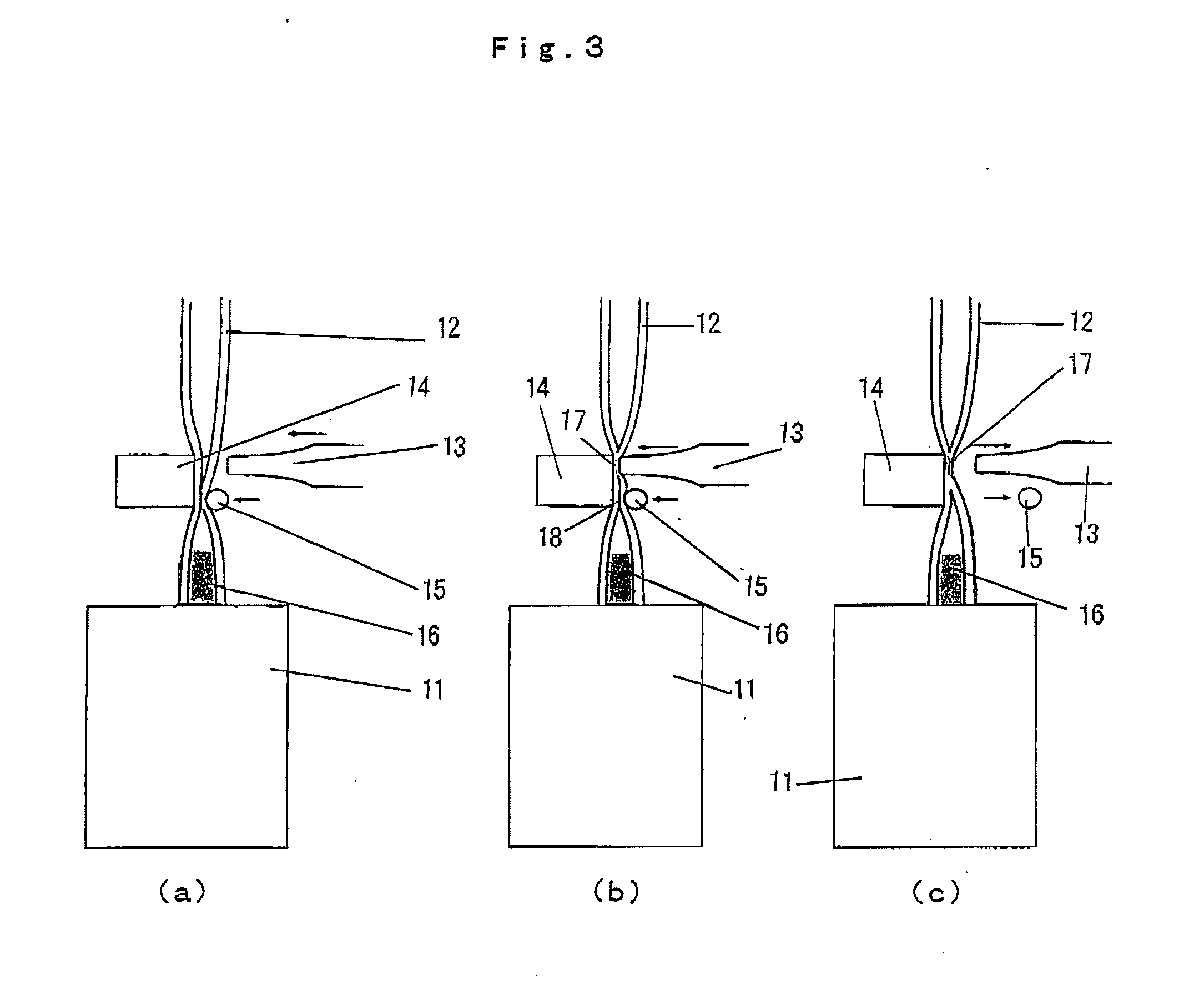Process for producing a plastic lens
a plastic lens and resin technology, applied in the field of plastic lens production, can solve the problems of high cleaning cost, large thickness of lens using resin, and small refractive index, and achieve the effect of high speed
- Summary
- Abstract
- Description
- Claims
- Application Information
AI Technical Summary
Benefits of technology
Problems solved by technology
Method used
Image
Examples
example 1
[0081] Using a polyethylene elastomer (manufactured by Sumitomo Chemical Co., Ltd., EXCELLEN FX) which was an olefin-based thermoplastic resin, a cylindrical gasket having an inlet which had a shape shown in FIG. 1 was obtained in accordance with the injection molding. The inner diameter of the cylindrical main portion of the gasket was about 80 mm, and the thickness of the wall of the inlet was 1.0 mm. Foreign substances on the surface of the gasket were removed by washing with pure water, and the gasket was sufficiently dried. Then, a glass upper mold member 3 and a glass lower mold member 4 were fitted into the openings of the cleaned cylindrical gasket as shown in FIG. 2, and a mold for a plastic lens was prepared.
[0082] A 23 liter tank of the closed type equipped with a stirring apparatus and a jacket was cooled by passing cold water adjusted at 5° C. through the jacket. Separately, 4,000 kg of 1,3-diisocyanatomethyl-cyclohexane cooled at 5° C. was weighed into a 5 liter vesse...
example 2
[0090] When lenses obtained in accordance with the process described in Example 1 were observed in detail, some of the lenses had slight clouding at portions in the vicinity of the inlet. When the clouding was observed by a microscope, it was found that the clouding was formed with aggregates of transparent foreign substance having a size of about 5 microns and irregular shapes which were estimated to be powder of the gasket resin formed during the ultrasonic welding. Based on this finding, the same monomer composition as that used in Example 1 was injected into the same mold for a plastic lens as that used in Example 1, and the inlet of the mold was welded in accordance with the production steps shown in FIG. 3 using an apparatus having an ultrasonic tube sealing machine under the condition of a frequency of 35 kHz, a pressure of welding of 0.5 MPa, a depth of welding of 1.0 mm and a time of oscillation of 0.5 seconds. In the first step, as shown in FIG. 3(a), a portion of the inle...
example 3
[0092] In accordance with the same procedures as those conducted in Example 2, an inlet in a mold for a lens in which the monomer composition had been injected was welded in accordance with the production steps shown in FIG. 4 using an apparatus having an ultrasonic tube sealing machine under the condition of a frequency of 35 kHz, a pressure of welding of 0.5 MPa, a depth of welding of 1.0 mm and a time of oscillation of 0.5 seconds. A step-shaped depression having a depth of 0.4 mm was formed on the holding faces of both of a hone 23 and an anvil 24 at the side of the cavity as shown in FIG. 4. When the inlet was held by the hone 23 and the anvil 24 under a pressure and the ultrasonic wave was transmitted, a welded portion 26 and a tightly closed unwelded portion 27 at the side of the cavity were formed simultaneously as shown in FIG. 4(b). Although it was estimated that powder of the gasket material was formed from the portion sealed by the welding 26 during the ultrasonic weldin...
PUM
| Property | Measurement | Unit |
|---|---|---|
| Pressure | aaaaa | aaaaa |
| Speed | aaaaa | aaaaa |
| Thermoplasticity | aaaaa | aaaaa |
Abstract
Description
Claims
Application Information
 Login to View More
Login to View More - R&D
- Intellectual Property
- Life Sciences
- Materials
- Tech Scout
- Unparalleled Data Quality
- Higher Quality Content
- 60% Fewer Hallucinations
Browse by: Latest US Patents, China's latest patents, Technical Efficacy Thesaurus, Application Domain, Technology Topic, Popular Technical Reports.
© 2025 PatSnap. All rights reserved.Legal|Privacy policy|Modern Slavery Act Transparency Statement|Sitemap|About US| Contact US: help@patsnap.com



